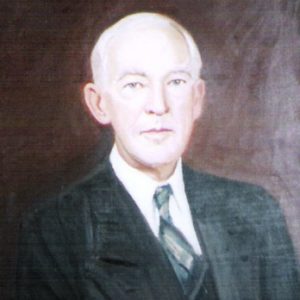calsfoundation@cals.org
William "Judge" Driver (1873–1948)
William Joshua “Judge” Driver of Mississippi County served as a member of the Arkansas legislature (1897–1899), as circuit judge in the Second Judicial District (1911–1918), and as U.S. representative from Arkansas’s First Congressional District (1921–1939). During his tenure in Washington DC, Driver served as president of the powerful National Rivers and Harbors Congress for many years and became chairman of that group’s board of directors in 1940. Driver used his position in the National Rivers and Harbors Congress to influence federal flood control legislation that greatly benefited Arkansas in the early twentieth century.
William Driver was born near Osceola (Mississippi County) on March 2, 1873, the second of John B. Driver and Margaret Ann Bowen Driver’s eight children. His father was a Civil War veteran involved in local politics. Driver attended Osceola schools, and, at eighteen years of age, studied law in the office of Judge G. W. Thomason and commenced practice in Osceola after being admitted to the bar in 1894. He married Clara Haynes of Memphis, Tennessee, on June 2, 1897, and they had one child. Early in his career, Driver acquired real estate later known as the Osceola Townsite Addition and converted it into town lots. He constructed concrete sidewalks and streets, which he named for his friends. The Osceola courthouse, the post office that later became the city hall, and the library were located in this addition. Driver eventually sold this property to the City of Osceola for one dollar.
Driver began his long career in flood prevention and flood control in 1893 when he helped his father organize the St. Francis Levee District and subsequently became that organization’s second president. While serving as a Democrat in the state legislature, Driver was instrumental in getting the first bond act passed that authorized levee boards to issue and sell bonds. After serving as circuit judge for the Second Judicial District from 1911 until 1918, Driver was elected to represent Arkansas’s First Congressional District in the U.S. House of Representatives in 1920. While serving in that chamber, he became a member of the House Flood Control Committee and the Rules Committee. Driver authored and guided through Congress the Flood Control Bills of 1923, 1928, and 1936, which became the basis for all subsequent flood control legislation and appropriation. Driver’s legislation authorized the creation of a system of locks and dams on tributaries of the Mississippi River to control water volume flowing into the Mississippi and provided funds for the enlargement of levees, revetment of banks, dredging of the channel, and elimination of obstructions, all of which hastened the flow of water to the Gulf of Mexico.
Driver served eight terms in the U.S. House of Representatives. Several factors contributed to Driver’s not winning his 1938 bid for reelection to Congress, including the aggressive campaigning of his young opponent, E. C. “Took” Gathings, as well as some behind-the-scenes acts of President Franklin Roosevelt, who worked against reelections of congressmen who opposed his court-packing proposal. Also, Driver neglected his own campaign to manage that of protégé John L. McClellan in his unsuccessful race for Hattie Caraway’s U.S. Senate seat. After Driver directed McClellan’s victorious senatorial campaign in 1942, McClellan stated, “I was fortunate to have [Driver’s] counsel in making many critical decisions; otherwise, I might have in some unguarded moment yielded to the persuasion of others.”
After he left Congress, Driver resumed his law practice in Osceola, became a public speaker, and continued to be involved in public service to his community, district, and state. He helped organize the Planters Bank at Osceola in 1944 and served as its president until his death on October 1, 1948. He is interred in Violet Cemetery in Osceola.
In 1959, the Osceola Bar Association sponsored a drive to erect a monument on the grounds of the Mississippi County courthouse to commemorate Osceola’s most distinguished citizen’s many years of public service. Senator McClellan gave the dedicatory address and unveiled the monument on September 16, 1959.
For additional information:
Osceola History File. Mississippi County Historical Society, Osceola, Arkansas.
“William Joshua Driver.” Biographical Directory of the United States Congress. http://bioguide.congress.gov/scripts/biodisplay.pl?index=D000503 (accessed April 25, 2022).
Sherry Laymon
Hot Springs National Park, Arkansas
 Congressional Delegation, 1934
Congressional Delegation, 1934  William Driver
William Driver 



Comments
No comments on this entry yet.